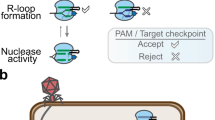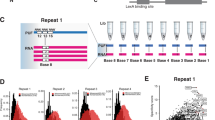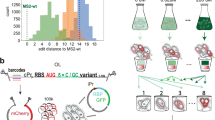Abstract
A zinc finger library with degenerate α-helices was displayed on the surface of bacteriophage and proteins that bind human immunodeficiency virus type-1 (HIV-1) Rev response element stem loop IIB (RRE-IIB) RNA or 5S rRNA were isolated. DNA encoding affinity selected zinc fingers was shuffled by recombination in vitro to isolate proteins with higher RNA binding affinity. Proteins constructed in this way bind RNA specifically both in vitro and in vivo . These results demonstrate that RNA substrate specificity of zinc fingers can be changed through mutation of α-helices to construct novel RNA binding proteins.
This is a preview of subscription content, access via your institution
Access options
Subscribe to this journal
Receive 12 print issues and online access
$189.00 per year
only $15.75 per issue
Buy this article
- Purchase on Springer Link
- Instant access to full article PDF
Prices may be subject to local taxes which are calculated during checkout




Similar content being viewed by others
References
Henikoff, S., et al. Science 278, 609–614 (1997).
Berg, J.M. et al. Science 271, 1081–1085 (1996).
Clemens, K.R. et al. Science 260, 530–533 (1993).
Joho, K.E. et al. Cell 61, 293–300 ( 1990).
Theunissen, O. et al. Cell 71, 679–690 ( 1992).
Choo, Y. et al. Nature 372, 642–645 (1994).
Rebar, E.J. et al. Science 263, 671–673 (1994).
Choo, Y. et al. Curr. Opin. Struc. Biol. 7, 117– 125 (1997).
Pomerantz, J.L. et al. Science 267, 93–96 ( 1995).
Friesen, W.J. et al. J. Biol. Chem. 272, 10994–10997 (1997).
Nakaseko, Y. et al. J. Mol. Biol. 228, 619–636 (1992).
Rebar, E.J. et al. Meth. Enz. 267, 129–149 (1996).
Smith, G.P. et al. Meth. Enz. 217, 228–257 (1993).
Pelham, H. et al. Proc. Natl. Acad. Sci. USA 77, 4170– 4174 (1980).
Hope, T. et al. Curr. Topics Micro. Immun. 193, 91– 105 (1995).
Kjems, J. et al. EMBO J. 11, 1119–1129 (1992).
Mann, D.A. et al. J. Mol. Biol 241, 193–207 (1994).
Tan, R. et al. Cell 73, 1031–1040 ( 1993).
Harada, K. et al. Nature 380, 175–179 (1996).
Stemmer, W.P. Proc. Natl. Acad. Sci. USA 91, 10747–10751 (1994).
Puglisi, J. et al. Science 270, 1200–1203 (1995).
Battiste, J.L. et al. Science 273, 1547–1551 (1996).
Sambrook, J. et al. Molecular cloning. A laboratory manual. (Cold Spring Harbor Laboratory Press; 1989).
Wuttke, D. et al. J. Mol. Biol. 273, 183–206 (1997).
Guex, N. et al. Protein Data Bank Quaterly Newsletter 77, 1996).
Acknowledgements
We thank E. Rebar and C. Pabo for fd.tet.7000; A. Frankel for pSV2TatRev and pHIV LTR-IIB CAT; T. Parslow for pCH110; and E W. Mercer for cell culture facilities.
Author information
Authors and Affiliations
Corresponding author
Rights and permissions
About this article
Cite this article
Friesen, W., Darby, M. Specific RNA binding proteins constructed from zinc fingers. Nat Struct Mol Biol 5, 543–546 (1998). https://doi.org/10.1038/794
Received:
Accepted:
Issue Date:
DOI: https://doi.org/10.1038/794
This article is cited by
-
Fingers reach for the genome
Nature Biotechnology (2003)
-
RNA-binding proteins tamed
Nature Structural & Molecular Biology (1998)



